This post may contain affiliate links.
Oscars are one of the most popular fish in the aquarium hobby. Owing to their beautiful colors, unique personality, and big bulging eyes that are always staring, it’s easy to fall in love with Oscar fish.
If you are new to setting up an Oscar tank and want to know how to care for these monster fish, this article is for you.
Oscar Fish Care: A Detailed Guide For Beginners

Before you bring home the Oscar fish, here is what you need to know:
- Oscars Cichlids grow incredibly fast, and you have to be ready for it. Under favorable conditions – given adequate space, clean water, and a proper diet – Oscar fish can grow up to 8 to 10 inches the first year. A fully grown, healthy Oscar can get as big as 12 to 14 inches. Some large specimens have been known to touch the 16-18 inches mark.
- Oscars exhibit a unique personality and tend to be quite expressive. You can quickly tell when they are excited, sad, or angry. Being a moody fish, the Oscars are great at putting up an act; we don’t call them drama queens for no reason.
- Oscars can be downright destructive to decorations if they don’t like what you have put into the tank or where it is placed. But you don’t have to bother because they will move around the decor as they please.
- Oscars are highly intelligent fish and inquisitive in nature. They recognize their owners and often come to the front of the tank to greet them. You can even train Oscar fish to eat food from your hand.
How to Set Up and Maintain an Oscar Fish Tank?
Get The Right Size Aquarium

75 gallons is the recommended size for an Oscar tank.
Some people will say it’s ok to keep an Oscar in a 55-gallon tank as long as there is adequate filtration and you are keeping up with the water changes.
No doubt your Oscar will survive, but in reality, a 55-gallon aquarium is too narrow for a fish (that grows up to 14 inches long) to turn around.
If you want to bring home an Oscar fish, you need to be willing to provide them with sufficient living space. The bigger the aquarium, the happier and healthier your fish are.
Ideal Water Parameters For Oscars
Even though Oscars are hardy fish capable of handling a wide range of water parameters, you must provide them with the most favorable conditions.
- Oscar fish prefer the temperature to be around 77 °F (25 °C), but they can also tolerate a range of 74–81 °F (23–27 °C).
- It is best to keep the water pH at around 7.2. However, it’s more important to maintain a stable pH between 6-8 at all times rather than chasing a particular value.
Filtration and Water Change
Oscars are known to be ‘dirty’ fish as they have big appetites and excrete a lot of waste. To keep an Oscar tank clean, you need to employ heavy filtration.
It’s best to choose a filter rated higher than your tank’s capacity. For instance, if you have a 75 gal tank, you would want at least a 100 gal filter to keep the water in optimal condition. Don’t worry; you can never over-filter an Oscar tank.
Besides adequate filtration, you need to have a strict water-changing schedule to remove the toxins from the water. Ideally, for a 75-gallon tank, you can do a 30% weekly water change.
During water changes, you should also vacuum the substrate to remove any residue the filter couldn’t remove.
Tank Decorations
When you make changes in Oscar’s environment, such as by adding decor items, it annoys the fish, and they will start tossing things up to rearrange the tank to their liking.
If you don’t want your decorations to be thrown around, go for items that are heavy enough for an Oscar to move. We are talking about big, heavy rocks and larger pieces of driftwood.
But before you move in any decor, inspect it carefully to ensure it has no sharp edges to prevent the fish from hurting himself.
If you plan to add live plants to your aquascape, you will probably have a hard time because Oscars love digging and uprooting plants. Sometimes they do it out of boredom, annoyance, or just for fun.
It’s important to note that Oscars are larger fish, and having too many decorations in the tank can significantly impede their movement, taking up the swimming space. So try to keep the decor to a minimum.
Is Heater a Necessity For Oscar Fish?
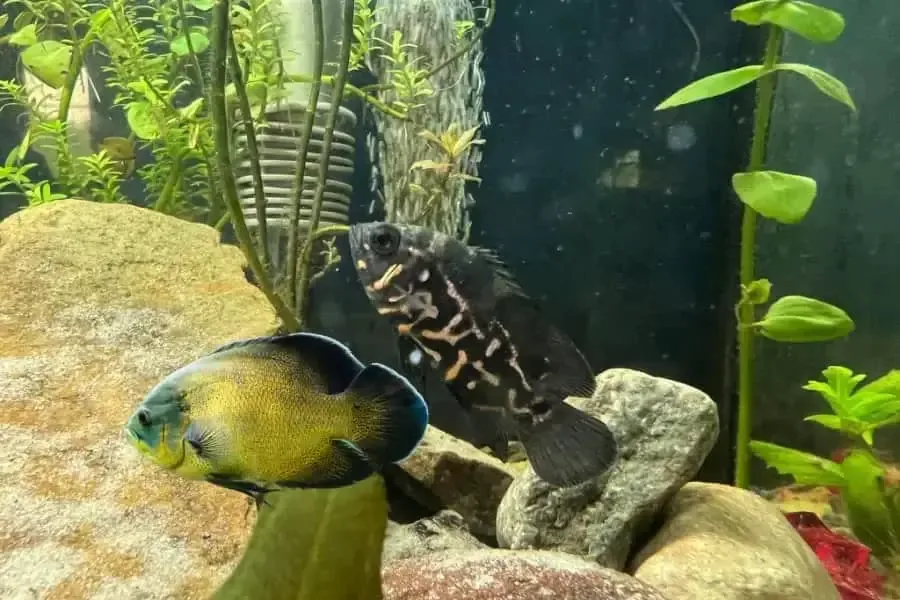
Oscars come from a tropical habitat and prefer a water temperature ranging from 74–81 °F (23–27 °C), whereas 77 °F (25 °C) being the most favorable.
If your room temperature often falls below the suggested range or fluctuates significantly, a heater is required to maintain a stable and suitable temperature for the fish. When the water gets too cold, it can suppress your Oscar’s immune system, making the fish stressed and vulnerable to illness.
If you are wondering what type of heater to get for your Oscar tank, buy an in-line external heater that can be linked to a canister filter.
You can even use an internal heating system by attaching it to the glass using quality suckers, but it will always be at risk of getting destroyed by the powerful Oscars.
Are Oscars Sensitive To Bright Lighting?
Though there is no evidence proving Oscar’s sensitivity towards bright lighting, many Oscar keepers have reported that their fish tends to retreat to the hideout as soon as the lights are switched on.
If your Oscar fish exhibits similar behavior, it could mean he is light-shy, probably because you’ve newly exposed him to high-intensity lighting.
Get some floating plants like water lettuce to slightly dim down the light to make your Oscar comfortable. You could also try covering the light with black paper and gradually pull it back every day until your Oscar has adapted to the lighting intensity.
Also, keep in mind that absurdly bright lights with high intensity may stress out your fish and cause discomfort.
Can Oscar Fish Live Without Air Pump?
You don’t need an air pump for your Oscar tank as long as you have a filter that keeps the tank’s water moving and adequately oxygenated.
However, if you notice your Oscar fish spending more time around the filter or often coming to the surface gasping for air, it indicates the lack of oxygen in the water. Only in such cases does getting an air pump or a bubbler become a necessity.
What To Feed Oscar Cichlids?
Oscar fish are primarily carnivorous. In the wild, their diet consists mainly of small fish, insects/larvae, and other aquatic prey. They have a voracious appetite and are known to be opportunistic feeders, devouring anything that fits into their mouths.
In captivity, Oscars can be fed high-quality pellets or stick such as TetraCichlid or Hikari Tropical. These commercial fish food claims to be nutritionally balanced to meet Oscar’s dietary needs.
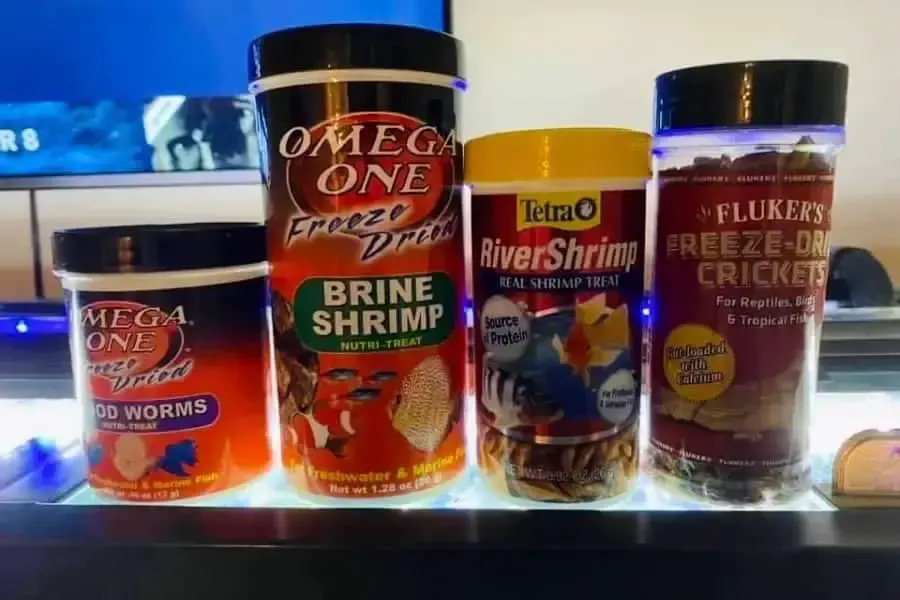
Commercial Oscar Fish Food
When it comes to live foods options, you can treat your Oscars with crayfish, crustaceans, mealworms, earthworms, bloodworms, soft-shelled crickets, krill, snails, ghost shrimp, mysis shrimp, moths, flies, and grasshoppers.
Occasionally offering live feeds with staple floating sticks not only introduces a variety in the diet but also provides Oscars with the necessary minerals, vitamins, or other constituents that might be missing in commercial fish food. If you cannot access live foods, go for frozen or freeze-dried items.
NOTE: It is not recommended to feed live food not more than once per week as it may lead to higher aggression and increase the chances of endoparasites. Also, the live food should be free of harmful bacteria and parasites.
What Not To Feed:
As important as knowing what to feed, one should also be aware of what not to feed and stay away from.
- Avoid land-based meat such as beef and poultry.
- Unless you breed your own feeder fish or know the supplier, do not feed them to your Oscars, as they may carry pathogens and cause disease transmission.
How Much To Feed An Oscar?
You might have heard the consensus that a fish should be given enough food it can eat in a few minutes or food equivalent to its eyeball.
While the former is not the correct way to measure the amount of food a fish may need, and the latter only applies to smaller fish.
So how much food should you feed Oscar fish? You may ask.
Well, there is no rule of thumb to go by. The feeding amount greatly varies depending on the size of your Oscar. You will be required to experiment with different food portions, and with trial and error, you shall determine the appetite of your Oscar fish.
No doubt Oscars are big eaters, and if given unlimited food, they will eat until they explode. They always seem hungry and beg for food no matter how much and how many times you feed them, making it harder to judge what’s enough and when to stop.
To get started, feed the number of pellets listed in the food package or recommended by your local fish store. Or you can take some suggestions from Oscar Fish forums on the internet. After that, if your Oscar is asking for more, give him slightly more.
During that day, carefully observe your fish. You want your Oscar to have a slightly rounded belly that is not swollen to look too concave.
Onto the next feedings, you can increase or decrease the amount depending on how your Oscar responds to the previous portion. Do it enough times, and soon you will know your fish’s appetite.
However, keep in mind the more food you put into your tank, the more water changes will be required to maintain the quality of the water.
How To Choose Tank Mates For Oscar Fish?

Although it is best to keep Oscars alone and as a focal point of the aquarium, if you persist in getting some tankmates, here are some factors to consider:
- Oscars are predatory creatures and will eat any fish that fits into their mouths.
- When choosing some ‘company’ for your Oscars, you must pay attention to the shape and size of the fish. Longer and slender bodies easily get eaten, while fat and round shapes are relatively safer.
- Despite their bigger sizes, Oscars are not overly aggressive (except during the spawning phase) and can be picked by other big fish, so it is wise to go with peaceful fish.
Top 10 Tank Mates For The Oscars
- Severum Cichlid
- Era Juanas Oscar
- Chocolate Cichlids
- Silver Dollars
- Common Pleco
- Geophagus
- True Parrot Cichlid
- Bala Shark
- Clown Loach
- Electric Blue Acara
How Many Oscars Can You Keep Together?
If you are willing to stock multiple Oscars in a monster tank, be prepared, as you may encounter a lot of aggression and territorial fights.
A 125-gallon tank is ideal for keeping 2 Oscars. However, some fishkeepers may argue that you even keep 3 Oscars. It’s doable, but your tank would be a little overstocked.
You will be required to employ heavy filtration systems to handle such a higher bioload. Check out Fluval FX6 Canister Filter.
Besides filtration, water changes are going to be of paramount importance. Expect to carry out at least 50-60% water change per week or 2 each of 35%.
NOTE: Stocking 3 Oscars (or in odd numbers) doesn’t go well and is not usually recommended. Oscars are often seen paring up and bullying the single fish to death.
How To Bring Out Best Colors In Oscar Fish?
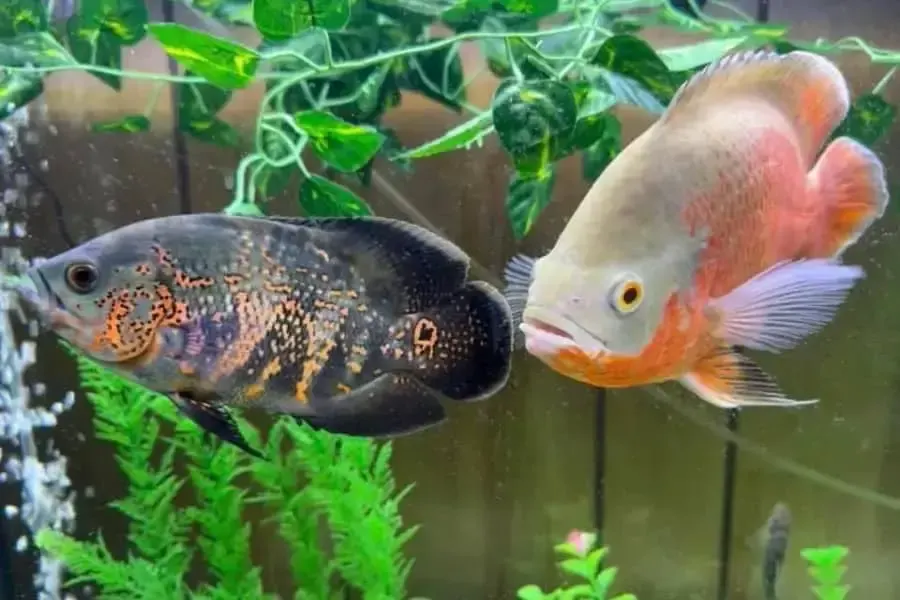
To enhance the color of your Oscar, you should focus on two things: a high-quality, varied diet and clean water.
Optimal water quality can be achieved by adequate filtration and weekly water changes. You need to maintain ideal water parameters, keeping the toxins in check.
Feed your Oscar a nutritionally rich varied diet by incorporating quality Cichlid sticks with live/frozen/or freeze-dried food options.
To bring out darker colors, use a black background and or dark substrate.
Common Oscar Fish Diseases – Symptoms, Causes, and Remedies
Getting familiar with common ailments is an essential part of Oscar’s care. It enables you for early diagnosis and timely prevention.
Hole In The Head (HITH)
If there is one disease Oscars are most susceptible to, it is hole in the head. It begins as small pits on the head and face, usually above the eye. If left untreated, it wouldn’t be long before the disease progressed into large cavities spreading along the lateral line.
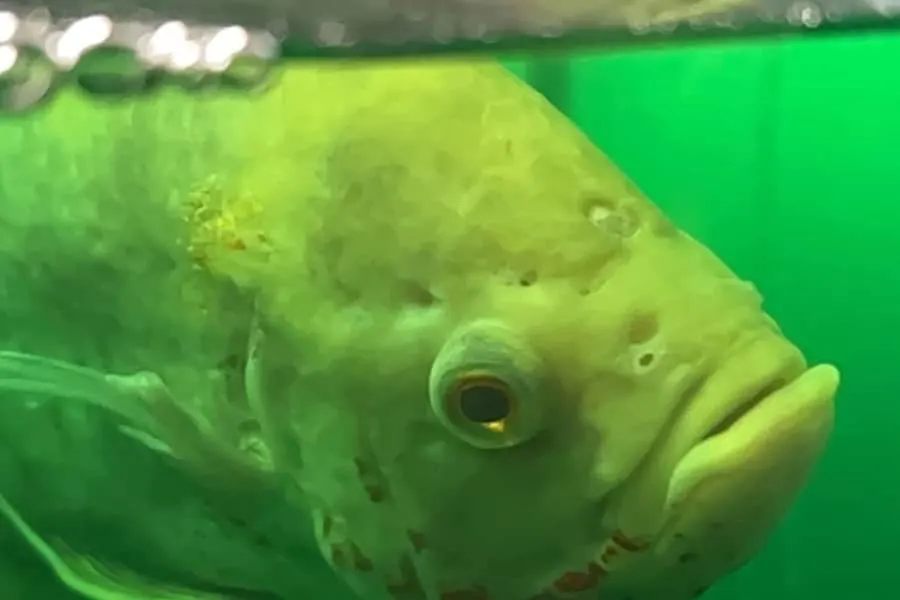
Hole In The Head Disease
There are a few causes for hold-in-the-head disease, including:
- Poor water quality
- Hexamita protozoa
- Inadequate diet or nutritional deficiency
Most of the time, dirty tank conditions are responsible for HITH in Oscars. For that reason, the first thing you should do is, test your water parameters. If the test kit measures excessive ammonia or nitrate levels, as an immediate treatment, make large water changes.
Since Hole is the head is also attributed to nutritional deficiency, you must review your Oscar diet and, if required, optimize it or introduce variety to meet their dietary requirements.
If your Oscar is excreting slimy, white mucous feces, it indicates the presence of the Hexamita parasite. In this case, you can use metronidazole, the most effective drug for treating Hexamita cases.
NOTE: Activated carbon is also believed to contribute to the hole-in-the-head disease. Chemical filtration, like carbon, can over-filter the water and removes the essential nutrients, resulting in the deficiency leading to HITH.
Ich (Ick) or White Spot Disease
Ich is another common disease Oscars are prone to. It is caused by protozoa called Ichthyophthirius multifiliis.
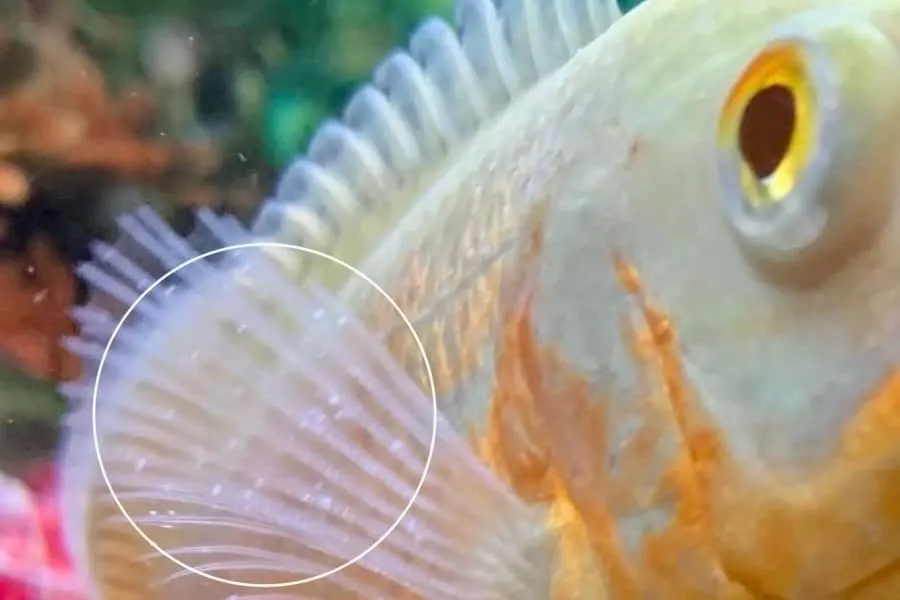
Ich (Ick) Or White Spot Disease
The symptoms of Ich include:
- Salt-like specks on the body/fins
- Excessive flashing (fish scratching or rubbing its body against solid objects)
- Subdued coloration
- Respiratory distress (labored or rapid breathing)
- Loss of appetite
- Lethargic or hiding behavior
To treat Ich, all you need to do is:
- Raise the water temperature to about 86 F for two weeks
- Add an air stone to increase aeration (as higher temperature reduces the amount of dissolved oxygen in the water)
- Add salt to the tank
- Treat with Ich-X medication
- Perform water changes and vacuum the gravel
Besides ich and hole in the head diseases, Oscar fish can also be susceptible to other diseases. Check out to learn about those diseases.
Breeding Oscar Cichlids
Before you consider breeding Oscar fish, here are some of the challenges that you may run into.
- Oscars are monomorphic. It means both males and females look the same and have nearly indistinguishable appearance, making it hard to find a pair.
- Even if you identify the male and female, they may get picky and refuse to pair up.
- A smaller female Oscar typically lays 300 to 500 eggs on their first spawning. Whereas a larger Oscar (10 to 14 inches) may produce 2,500 to 3,000 eggs. You will need help finding a home for so many fish.
After reading and contemplating the above points, if you persist in your decision to move forward, here is your beginner-friendly step-by-step guide on breeding the beautiful Oscars.
Form an Oscar pair:
- Make a visit to your local fish store and buy a group of six baby Oscars.
- Then wait until they are old enough to form a pair. It takes around 14 months for Oscar fish to reach sexual maturity.
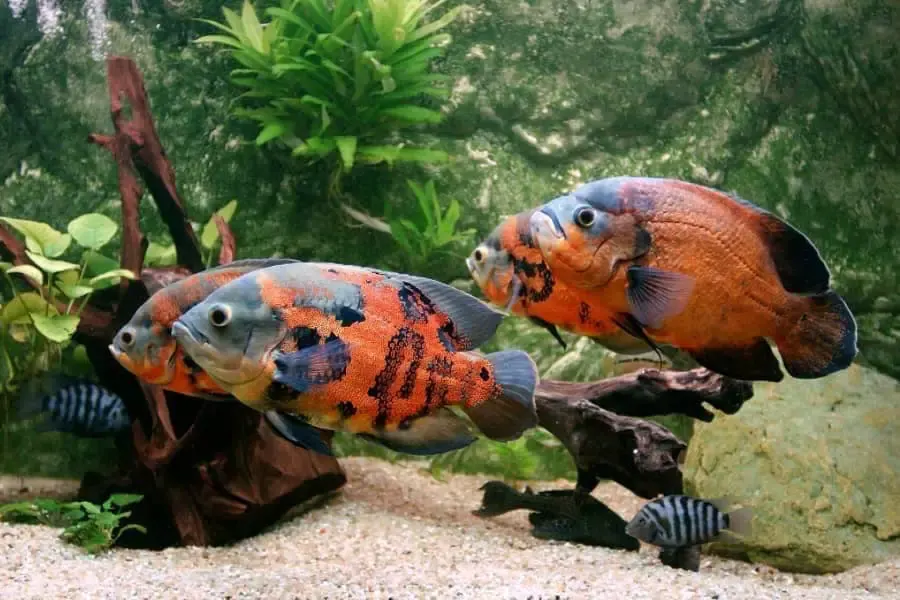
Two Pairs Of Oscar Fish
Once you have a pair, allocate them a separate tank or move out the other four fish.
Provide Adequate Conditions:
- A minimum of a 75-gallon tank should be used for breeding a pair of 6-inch Oscar fish.
- Inspect your filter to ensure it’s working optimally.
- Change 30-50 percent of the aquarium water once a week.
- Maintain a stable temperature of 82 to 85 degrees Fahrenheit.
- Feed an enriched diet to the breeding pair. An inadequate diet often results in eggs failing to hatch or weak fry dying off in the first week after becoming free swimming.
- Oscars prefer to lay their eggs on a flat surface instead of laying directly on the substrate. It would be wise of you to place a wide flat rock or slate into the aquarium.
Signs of Breeding:
- When a pair of breeding Oscars is ready to spawn, they exhibit certain signs and behavior, including lip/jaw locking, fin flaring, vibrating the body, chasing each other around the tank, and swimming with fin erect.
- You may notice male Oscar (in some cases female as well) cleaning or scrubbing the flat surface as a preparation for the female to lay her eggs.
NOTE: Once the eggs have hatched (which usually taken 2 to 3 days), move the fry into a smaller grow-out tank. Leaving them in the same tank may result in the parent fish devouring their young ones.
Wrapping Up
Oscars are undoubtedly one of the most desirable freshwater fish. They are hardy and easy to care for, making them beginner-friendly fish.
We hope, with the information shared above, you feel confident enough to set up your Oscar tank and receive the privilege of having these beautifully gorgeous fish as your pet.
